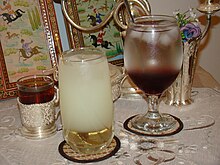**Etymology and History**:
– The term “sharbat” comes from the Persian word meaning a drink of sugar and water.
– Originated from the Arabic word ‘shariba,’ evolving to mean an alcoholic beverage.
– Persian and Turkish variations of ‘sharbat’ meant sweet non-alcoholic beverages.
– Sharbat believed to originate in Iran (Persia).
– Sharbat traditionally made with cane juice but now commonly made with sugar and water.
– Introduced to Europe during the Middle Ages.
– Sharbat was considered a luxurious beverage in ancient times.
– Introduced in India by the Mughals in the 16th century.
**Varieties and Consumption**:
– Tamarind sherbet popular in Muslim countries during Ramadan.
– Almond sherbet possibly of Persian origin, spiced with cardamom and kewra.
– Bael ka sharbat flavored with salt, pepper, mentha, sugar, and lemon juice.
– South Indian version called ‘sarbbath’ popular in Kerala, Tamil Nadu, and Andhra Pradesh.
– Indonesian drink ‘serbat’ found during Ramadan.
– Sharbat flavors include basil seeds, rose water, sandalwood, hibiscus, lemon, orange, mango, pineapple, grape, and chia seeds.
– Sharbat popular in Iran, Turkey, Bosnia, Arab world, Afghanistan, Pakistan, Sri Lanka, Bangladesh, and India.
**Middle Eastern Influence**:
– Ottoman Muslims favored sherbet over alcoholic beverages.
– Sherbet came in syrups, pastes, and tablets.
– Sherbet production has declined but syrups are still made in some Turkish regions.
– Pastes are rare and limited to bergamot or mastic flavors.
– Tablets were a specialty item made with fruit juices, essential oils, and spices.
– Fruits and syrups used in Ottoman sherbets included pomegranates, plums, apricots, peaches, and cherries.
**Cultural Significance and Traditional Recipes**:
– Sherbet plays a role in various cultural celebrations and rituals.
– Sherbet has been mentioned in historical texts and literature.
– Traditional sherbet recipes vary across different cultures.
– Common flavors of traditional sherbet include lemon, peach, and apple.
– Some recipes include herbs and spices for added flavor.
– Sherbet making is considered an art passed down through generations.
**Modern Variations and Health Benefits**:
– Modern sherbet recipes may include dairy or non-dairy ingredients.
– Some flavors include exotic fruits like lychee and passion fruit.
– Commercially produced and sold in stores.
– Sherbet is popular as a dessert or a refreshing drink.
– Health benefits include being a good source of vitamin C, hydration, antioxidants, and a lighter alternative to ice cream.
– Sugar-free and low-calorie options available for health-conscious consumers.
Sharbat (Persian: شربت, pronounced [ʃæɾˈbæt]; also transliterated as shorbot, šerbet or sherbet) is a drink prepared from fruit or flower petals. It is a sweet cordial, and usually served chilled. It can be served in concentrated form and eaten with a spoon or diluted with water to create the drink.

Popular sharbats are made of one or more of the following: basil seeds, rose water, fresh rose petals, sandalwood, bael, hibiscus, lemon, orange, mango, pineapple, grape, falsa (Grewia asiatica) and chia seeds.
Sharbat is common in homes of Iran, Turkey, Bosnia, Arab world, Afghanistan, Pakistan, Sri Lanka, Bangladesh and India, and popularly consumed by Muslims when breaking their daily fast during the month of Ramadan.
A South Indian version commonly called sarbbath is popular in Kerala, Tamil Nadu and Andhra Pradesh, regions wherein a specially made syrup of Indian sarsaparilla and lemon is dissolved in milk or soda water.[citation needed]
An Indonesian, especially Javanese, drink called serbat is commonly found during the month of Ramadan. The most popular is made by mixing cold water, simple syrup, and shredded cantaloupe, popularly known as serbat blewah or cantaloupe sherbet.
